Introducing Petra – The Rose Red City

There’s something magnetic about Petra. The way its rose-red cliffs catch the morning light. The hush of the narrow Siq as it guides you to reveal a carved treasure, and the awe that settles in when you finally lay eyes on Al-Khazneh. In my years of working with travelers and exploring Jordan’s treasures, no site captures hearts like Petra.
This Petra Jordan Travel Guide brings together practical tips, must-see highlights, and personal insights, everything you need to make your visit to Jordan unforgettable.
More than just a famous landmark, Petra is a living story carved into the heart rocks of the Jordanian desert. It’s a UNESCO World Heritage Site, one of the New Seven Wonders of the World, and a dream destination for adventurers, historians, photographers, and anyone craving a walk through time and wonders. This guide brings together practical tips, must-see highlights, and a personal insights —everything you need to make your visit to Jordan unforgettable.
My Name is Khalid Alnobani . A Local Expert who grow up surrounded by timeless wonders, natural beauty and Today we will discover What makes Petra A MUST SEE Destination for every traveler through this comprehensive Petra Jordan Travel Guide.
Let’s begin your journey into the heart of Petra.
A Brief History of Petra
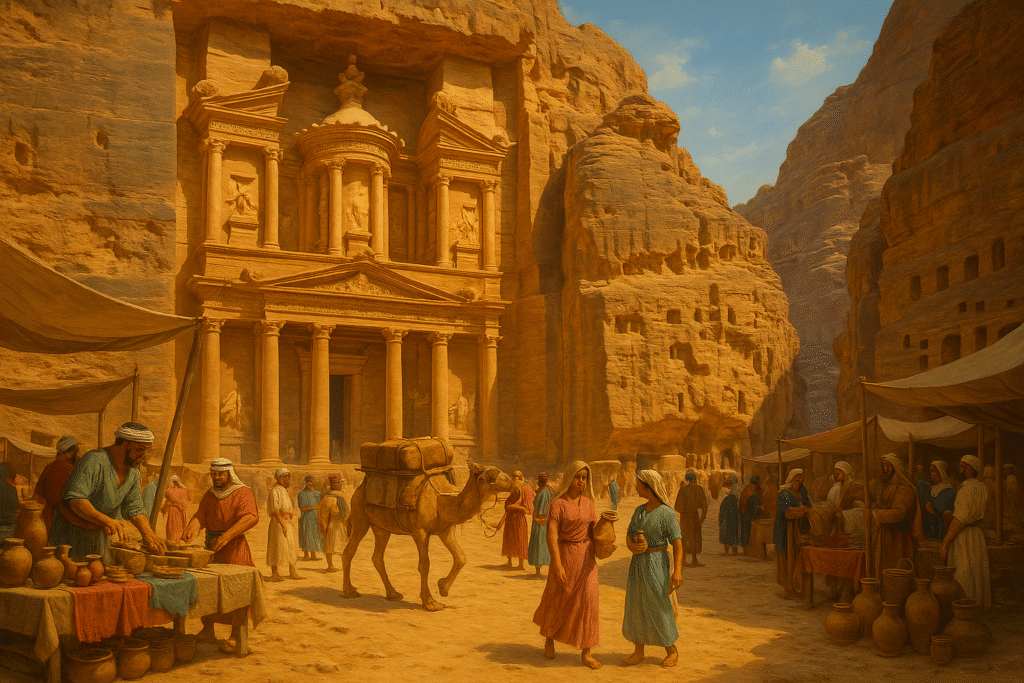
Long before Petra became Jordan’s most iconic tourist attraction, it was the beating heart of an ancient kingdom. Founded by the Nabataeans over 2,000 years ago. Petra thrived as a powerful trade center connecting Arabia, Egypt, and the Mediterranean world together. These skilled engineers carved an entire city into sandstone cliffs, complete with temples, tombs, and a sophisticated water system that kept life flowing even in the harsh desert.
But Petra’s golden age eventually faded. After a major earthquake in the 4th century AD and shifting trade routes, the city was gradually abandoned for centuries and the desert reclaimed the city. Petra remained hidden to the Western world—until 1812. When Swiss explorer Johann Ludwig Burckhardt heard story’s about a lost city nested in the heart of Jordan desert, he disguised as a Bedouin, Uncovering a discovery that immortalized his name for generations and led to the rediscovery of the lost city of Petra.
Today, Petra stands as a testament to human creativity, resilience, and the enduring mystery of civilizations past. As you walk its ancient paths, you will notice you’re not just visiting a site—you’re stepping into a story that has been unfolding for millennia.
Today, as you explore this site with the help of our Petra Jordan Travel Guide, you’ll find not just ruins, but the living essence of a civilization. This guide is designed to enhance your visit, providing both logistical advice and cultural insight that will help you fully appreciate the magic of Petra.
How to Get to Petra
Reaching Petra is easier than most people think—and the journey itself is part of the adventure. Whether you’re flying into Jordan or already exploring nearby cities, there are several convenient routes to this iconic site depending on your arriving Point lets discover it with this Petra Jordan Travel Guide.
From Amman: Petra is about 230 km (143 miles) south of Amman, Jordan’s capital. The drive takes around 3 to 3.5 hours by car via the Desert Highway (Route 15) or the more scenic King’s Highway. Private transfers, rental cars, and guided day trips are all available from Amman.
From Aqaba: Coming from Jordan’s southern port city? Petra is about a 2-hour drive (125 km). This route is especially popular with travelers arriving by cruise ship or exploring Wadi Rum and the Red Sea.
By Bus: The JETT bus company offers a daily tourist service from Amman and Aqaba to Petra (Wadi Musa). It’s affordable, comfortable, and great for independent travelers.
From Israel or the West Bank: Visitors can cross into Jordan via the Wadi Araba, King Hussein/Allenby, or Sheikh Hussein border crossings. Once in Jordan, transport can be arranged via tour operator, taxi, or rental car.
Nearby Airports:
- Queen Alia International Airport (AMM – Amman): 3 hours to Petra
- King Hussein International Airport (AQJ – Aqaba): 2 hours to Petra
Local Tip: Many visitors combine Petra with Wadi Rum and the Dead Sea in a multi-day tour—it’s a seamless and rewarding route through Jordan’s southern wonders. Want to know more about—Planning a trip To Petra Contact us .
Petra Site Highlights: What Not to Miss
Petra is massive much more than just the Treasury. To truly appreciate its scale and beauty, it’s essential to know what to look out for as you explore Petra. Here are the must-see highlights within the ancient city of Petra:
The Siq:
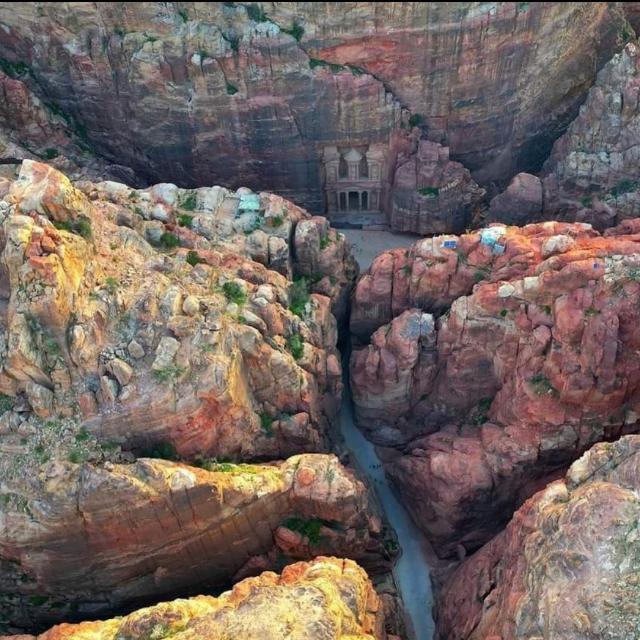
Your journey begins with a narrow, winding gorge nearly a kilometer long. Towering 80-meter-high sandstone walls surround you, creating an almost otherworldly silence. Along the way, keep an eye out for ancient water channels and carvings tucked into the cliffs—remnants of Nabataean ingenuity.
As you near the end of the Siq, a sliver of light suddenly reveals the grandeur of Al-Khazneh (The Treasury), slowly coming into view like a hidden gem. This dramatic unveiling is one of the most unforgettable travel moments I have witnessed.
Al-Khazneh (The Treasury):
The most breathtaking and iconic landmark in Petra, this 40-meter-high masterpiece carved directly into rose-colored sandstone is the reward that greets you after your walk through the Siq. Believed to have been a royal tomb or temple, The Treasury has inspired countless legends—including tales of hidden treasure sealed within.
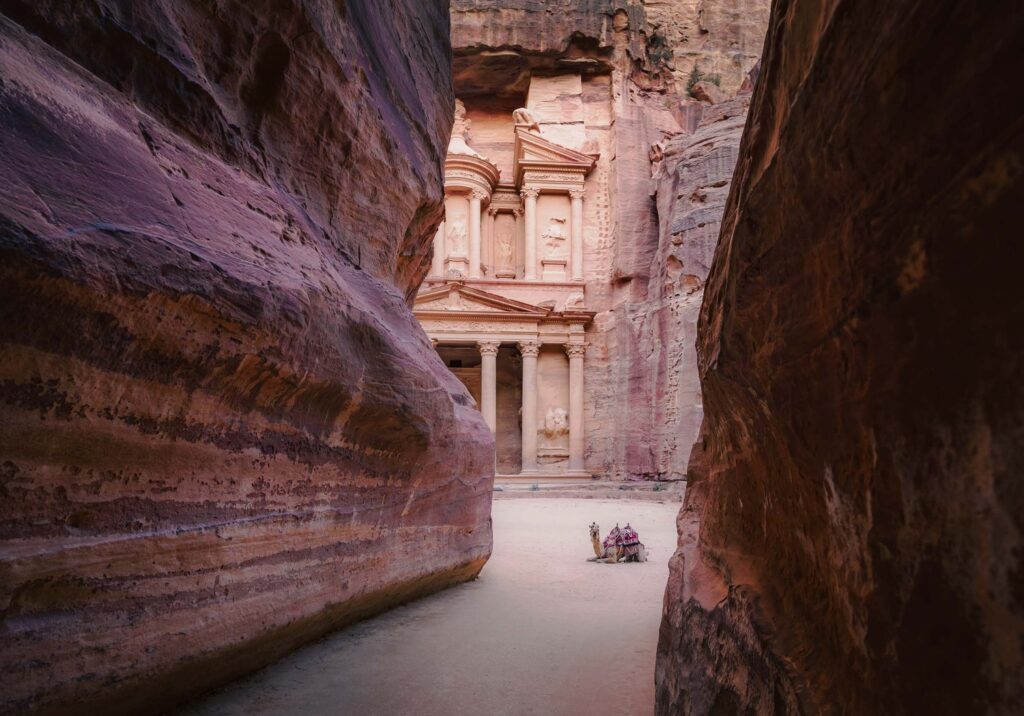
A story often shared by local Bedouins tells of a traveler who, upon emerging from the shadows of the Siq and seeing the Treasury for the first time, was so overwhelmed he fell to his knees in silence. That moment of awe, they say, is not uncommon. Whether you see it in person or on screen, nothing compares to the real-life experience of standing before this ancient wonder—watching the sunlight dance across its perfectly sculpted columns.
The Street of Facades:
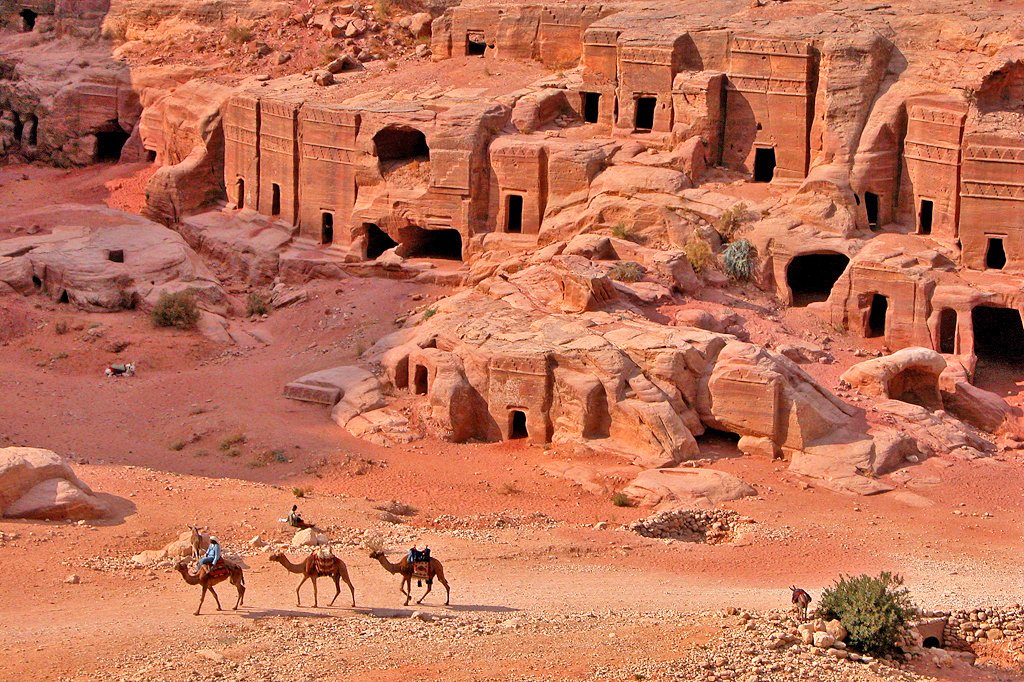
A row of towering tombs with intricate carvings built into the cliff face. Expect to see dozens of chambered entrances with striking facades, giving you a real sense of how Petra’s nobility honored their dead.
The Theatre:
With seating for up to 7,000 people, Petra’s stone-carved theatre blends Nabataean design with Roman influence. Entirely sculpted from the cliff itself, it’s an architectural marvel where public ceremonies, gatherings, and performances once echoed through the canyons.
Expect to see rows of steep seating that rise around the semicircular stage, offering insight into how Petra’s citizens celebrated civic and spiritual life. Stand at the center, and you might feel the ancient voices that once filled the air …. Magnificent .
The Royal Tombs:
A row of monumental burial chambers including the Urn Tomb, Silk Tomb, and Palace Tomb. Climb up for panoramic views across the valley.
The Monastery (Ad-Deir):
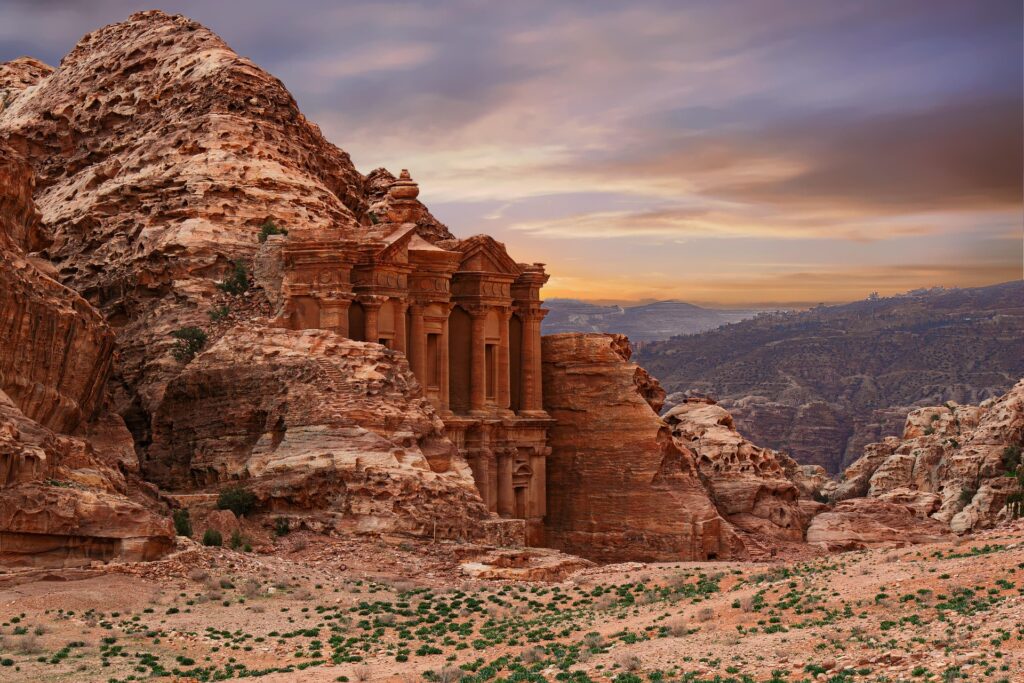
Located at the top of nearly 800 rock-cut steps, this massive monument rivals the Treasury in both size and grandeur—and many say it’s even more impressive. You’ll be rewarded with sweeping mountain views and a sense of peaceful solitude that’s hard to find at more crowded spots.
Expect to see a colossal façade carved deep into the mountainside, flanked by caves and panoramic trails. A local guide once shared how a hiker, stunned by the beauty after the climb, sat quietly for an hour sketching the monument by hand, saying it felt like discovering a secret kept by the mountains themselves.
High Place of Sacrifice:
An ancient ceremonial site offering stunning views over Petra. The climb is steep, but the sense of history and perspective from the top is worth it.
Byzantine Church & Petra Museum:
Don’t miss the intricately mosaicked floors of the church or the small museum that sheds light on Petra’s rich layers of history.
Local Tip: Start early in the morning to beat the heat and the crowds, and don’t try to see it all in one day. Petra deserves time and energy—let it unfold slowly, Consider Taking Petra back rout starting From the Little Petra and end in the Treasury. Make sure you read a Petra Jordan Travel Guide for better insight about Petra.
Need more information about Petra Back rout , Contact us.
Best Time to Visit Petra
Petra is open year-round, but not every season offers the same experience. Jordan’s desert climate means weather can vary greatly depending on the time of year. In winter, Petra can experience periods of heavy rainfall. When this happens, the site may be closed temporarily for safety reasons due to flooding risk in the Siq and surrounding trails. Always check local weather updates and the official Petra authority announcements before your visit during the colder months and we ill sure keep you updated.
Spring (March to May):
This is the best time to visit Petra. Temperatures are mild, wildflowers bloom across the desert, and the skies are crystal clear—perfect for exploring and photography.
Autumn (September to November):
Another ideal time. The heat of summer fades, but the daylight remains long enough to explore comfortably. This is also peak season, so book hotels and tours in advance.
Summer (June to August):
It gets very hot, especially midday. If visiting during summer, plan early morning or late afternoon tours and stay hydrated. It’s also less crowded.
Winter (December to February):
Expect cooler temperatures and occasional rain. The site is quieter, but parts of Petra may be slippery or muddy. Dress in layers.
Petra by Night:
A magical experience now available every night starting from 1 May 2025 (Instead of Monday, Wednesday, Thursday). Over 1,500 candles illuminate the path through the Siq all the way to the Treasury, creating a breathtaking atmosphere unlike anything else. Tickets cost 42 USD per person, and no pre-booking is needed just purchase your ticket at the Visitor Center and enter. make sure your itinerary have an overnight in Petra no package to Jordan is complete without an overnight in Petra , don’t miss this once-in-a-lifetime moment under the stars.
Entrance Fees & Opening Hours
Petra is open daily, and basically there are two ticket categories: one for Arab nationals and another for non-Arab visitors. The price also varies based on the number of days you plan to visit and today with our Petra Jordan Travel Guide we will get to know the entrance fees cost:
Standard Entrance Fees (as of 2025):
- 1-Day Ticket: 50 JOD (approx. 70 USD) | for Jordan pass Please choose Jordan Wanderer ticket.
- 2-Day Ticket: 55 JOD (approx. 77 USD) | for Jordan pass Please choose Jordan Explorer ticket.
- 3-Day Ticket: 60 JOD (approx. 84 USD) | for Jordan pass Please choose Jordan Expert ticket.
Children under 12 years old: Free of charge.
Opening Hours:
- Summer: 6:00 AM – 6:00 PM
- Winter : 6:00 AM – 4:00 PM
Local Tip: Arrive early in the morning to make the most of your time and avoid peak heat and crowds. The Jordan Pass is highly recommended for travelers from non-restricted nationalities—it saves both time and money by covering Petra’s entry fees, granting access to over 40 attractions across Jordan, and including your Jordan visa fees if you stay a minimum of two nights.
Tips for Visiting Petra
Visiting Petra can be one of the most rewarding experiences of your life—but a little preparation goes a long way. Here are some essential travel tips I always share with my guests:
Wear the right shoes:
Expect to walk for hours—on gravel, steps, and uneven terrain. Sturdy walking or hiking shoes are essential. On the other hand, you can enjoy a horse ride or even a cart ride that takes you all the way to the Treasury. But there’s no need to rush—walking through the Siq is part of the magic. The narrow gorge, lined with towering sandstone cliffs, is stunning in itself and walking it takes between 30 minutes and 1 hour depending on your pace. For a fit traveler, it can take as little as 20 minutes. The reward? One of the most breathtaking moments: your first glimpse of the Treasury gradually revealing itself at the end.
Start early:
The gates open at 6:00 AM. Arriving early helps you beat the heat and enjoy the major sights like the Treasury before the crowds roll in. Hire a local guide—I’ll keep reminding you throughout this article because the difference it makes is truly worth it.
Stay hydrated:
You’re in the desert carry plenty of water. Refill points are available near major landmarks, but having your own bottle is a must, make Sure you always carry Water especially in the south (Petra and Wadi Rum).
Pace yourself:
Petra is enormous—much more than just the Siq and the Treasury. It was once a thriving city filled with life, culture, and commerce. If your schedule allows, spread your visit across two days so you can take it all in without rushing and appreciate the scale of what was once a living, breathing metropolis carved into stone. ”Check out our 2 Days to Petra From Amman”
Hire a local guide:
A good guide will share stories, history, and insider knowledge that can transform your experience. Many know hidden paths and scenic spots that most visitors would never find on their own. Even if just for a few hours, it’s worth it. And here’s a tip—consider tipping your guide to take you up to the Monastery or the Treasury viewpoint. You’ll thank me later
Pack smart:
Bring sunscreen, a hat, sunglasses, snacks, and layers—especially in winter when mornings can be cold but afternoons warm.
Respect the site:
Stick to marked paths, don’t climb monuments without a Local Guide, and avoid touching fragile structures. Petra is a UNESCO World Heritage Site and needs to be preserved.
Local Tip: The horse ride from the Visitor Center to the Siq entrance is technically included in your ticket—but tipping is expected and the Bedouin wont leave you until you tip Them ”sorry for That”. Many visitors choose to walk the 10–15 minutes instead.
Where to Stay Near Petra
Most visitors to Petra stay in the nearby town of Wadi Musa, which is just minutes from the Petra Visitor Center. The town offers a wide range of accommodations for every type of traveler, from luxury seekers to budget backpackers. I will also mention the best hotels based on location that are within walking distance to the Petra Visitor Center—because trust me, proximity matters when you want to catch Petra at sunrise or unwind quickly after a long day exploring.
This section of our Petra Jordan Travel Guide covers top-rated hotels in Petra and local stays within walking distance of the Petra Visitor Center, from luxury resorts to authentic Bedouin camps..
Luxury Hotels:
- Mövenpick Resort Petra: Located just steps from the entrance gate, this highly recommended property offers top-tier service, an oriental-style rooftop terrace, and a perfect post-hike spa experience.
- Marriott Petra Hotel: Situated slightly uphill but still within close driving distance to the Visitor Center, this hotel offers exceptional views, five-star amenities, and a peaceful atmosphere ideal for winding down after a full day of exploration.
Mid-Range & Boutique Options:
- Old Village Hotel & Resort: A charming and peaceful stay just a short drive away, with traditional architecture and mountain views.
- Petra Moon Hotel: Known for its clean rooms, rooftop pool, and friendly staff—all within walking distance of Petra.
- Petra Guest House Hotel: Located directly beside the entrance to Petra, this hotel offers unbeatable access to the site and features the famous Cave Bar—a great spot to relax after a long day of exploring. It is also the closest hotel to the Petra Visitor Center, making it a top choice for convenience and location.
- H Luxury Hotel: Formerly known as the Candles Hotel, this recently upgraded 5-star property combines elegant comfort with an excellent location just minutes from the Petra gate. Ideal for travelers who want both luxury and convenience at a great value.
Budget-Friendly:
- La Maison Hotel: A solid mid-range option located just a short walk from the Petra Visitor Center, offering comfort, convenience, and one of the best locations in town for early site access. Highly recommended for a 3-star—in my personal opinion, this is the best hotel in Petra within the 3-star category.
- Icon Hotel: A newer property offering modern amenities and a great location within walking distance of the Petra Visitor Center—perfect for early risers and relaxed returns.
If Petra Town is Fully Booked
If accommodations in Wadi Musa are fully booked, consider staying nearby in Al Bayda (Little Petra area) or the surrounding countryside. Here are two great alternatives:
- Al Beda Luxury Camp: A Bedouin-style luxury camp offering peaceful mountain views and traditional hospitality. Located just a short drive from Petra’s back entrance, it’s a great choice for traveler who want to start from the back rout in Petra.
- Seven Wonders Bedouin Camp: A popular option among hikers and backpackers located near Little Petra. Known for its authentic vibe, friendly staff, and evening campfire atmosphere, it’s only a 15–20 minute drive from the main Petra Visitor Center.
Local Tip: Book your accommodation in advance if you’re visiting during peak seasons (spring and autumn), as Petra is often fully booked during these times, so make sure you reserve early. Also, consider choosing a place that is Near the visitor Center, many travelers like to start their Petra visit right at sunrise.
Contact Local Expert for the best Advice and Prices.
What to Pack for Petra?
One of the most common questions we get from travelers using our Petra Jordan Travel Guide is what to bring—this checklist ensures you’re ready for every trail, climb, and photo opportunity.
Preparing properly can make your experience at Petra much more enjoyable. The site is vast, the terrain varies, and the weather can change quickly. Here’s a smart packing checklist to help you get the most out of your visit:
Comfortable walking shoes: You’ll cover several kilometers on uneven paths, sturdy, broken-in shoes are a must.
Daypack: A lightweight backpack to carry your essentials like water, snacks, and personal items.
Water bottle: Stay hydrated, especially in the warmer months. Refill stations are available but it’s always a good Idea to have your own bottle. Petra is nested in the Deseret and in the summer it can get really hot during the Day.
Sun protection: Sunscreen, a wide-brimmed hat, and sunglasses are essential, even in cooler months.
Weather-appropriate clothing: Layered outfits are best, especially in spring and winter when mornings are chilly but afternoons are warm.
Snacks: Small energy bars or fruit can be handy during long walks without food vendors nearby.
Portable phone charger: You’ll likely take a lot of photos, make sure your phone stays powered.
Camera or phone : Petra is incredibly photogenic; don’t miss the chance to capture it for a lifetime lasting memories.
Cash: While many places accept cards, small purchases, tips, and local stands often require cash.
Local Tip: If you’re planning to hike to the Monastery or explore hidden trails with a guide, pack light, but don’t forget extra water and a scarf to protect against sun or wind.
How to Plan Your Day in Petra (Suggested Itineraries)
Planning your day at Petra can make a big difference in how much you see and how deeply you experience it. Here’s a simple breakdown to help you make the most of your time:
1-Day Itinerary (For the Efficient Explorer):
- 6:00 AM: Arrive early and walk through the Siq to catch the Treasury in the soft morning light.
- 7:00 AM – 9:00 AM: Explore the Street of Facades, the Theatre, and climb to the Royal Tombs.
- 9:30 AM – 12:00 PM: Make the hike up to the Monastery (Ad-Deir). Allow time for breaks and photos.
- 12:00 PM – 1:00 PM: Rest and enjoy lunch at the nearby café by the Monastery or back near the Basin Restaurant.
- 1:00 PM – 3:00 PM: Explore the Colonnaded Street, Qasr al-Bint, and Petra Church.
- 3:00 PM – 4:30 PM: Optional hike to the High Place of Sacrifice for a panoramic sunset.
- Evening: Consider staying for Petra by Night available Every Day Starting 1 May 2025—an unforgettable candlelit experience.
2-Day Itinerary (For the Deep Explorer):
Day 1:
- Follow the full 1-day itinerary at a slower pace.
- Include time to stop at the Petra Museum or take a guided tour.
Day 2:
- Start from Little Petra (Al Bayda) if staying nearby (Beda Camp we mentioned Earlier) enter via the back trail to the Monastery.
- Revisit your favorite spots, or explore lesser-seen sites like the Garden Temple, Soldier Tomb, or hike additional trails.
This part of our Petra Jordan Travel Guide breaks down how to structure your day to see the most while enjoying every step, Petra promise magic at every corner.
Local Tip: Most travelers are surprised by Petra’s scale. Give yourself the gift of time, and always wear good shoes, bring snacks, and hydrate often.
Beyond Petra – Sites to Combine with Your Visit
Petra is undoubtedly the crown jewel of Jordan, but your adventure doesn’t have to end at its gates. Our full Petra Jordan Travel Guide wouldn’t be complete without showing you where to go next—because Petra is just one piece of Jordan’s incredible travel story.
Many travelers combine Petra with nearby sites that add depth and variety to the journey:
Wadi Rum – The Valley of the Moon:
Just a 60-minute drive south of Petra, this Martian-like desert landscape offers jeep safaris, stargazing, camel rides, and overnight stays in Bedouin camps. It’s the perfect contrast to Petra’s ancient architecture.
Roughly 3–4 hours drive north of Petra, the Dead Sea is the lowest point on Earth. After days of trekking, reward yourself with a therapeutic float and a mineral-rich mud bath.
Little Petra (Al Bayda)
Often overlooked, this small Nabataean site is just 15 minutes from Petra and features carved facades, stairways, and cisterns, ideal for a peaceful warm-up or follow-up to Petra. Bonus: it’s also the starting point for the back trail hike to the Monastery.
Aqaba – Red Sea Getaway
A 2-hour drive from Petra, Aqaba is a laid-back seaside escape great for snorkeling, diving, or just relaxing after exploring Jordan’s interior, Consider visiting Aqaba after Wadi Rum its only 30 Min Drive.
Mount Nebo & Madaba – Mosaic & Biblical Views:
North of Petra via the King’s Highway, these sites offer rich religious history and stunning views. Mount Nebo is where Moses is said to have seen the Promised Land, and Madaba is home to the famous Byzantine mosaic map, Consider Vesting when heading Back To Amman Mount Nebo and Madaba is only a 1 hour Drive From Amman.
Local Tip: If time allows, book a multi-day tour that links Petra with Wadi Rum, the Dead Sea, and Amman. This loop gives you a full picture of Jordan’s culture, history, and nature.
Need Help Planning your Trip To Jordan , contact your Local Expert we reply within 2 hour.
Final Thoughts & Local Advice
Petra is more than a bucket list destination—it’s a living memory that stays with you. From the quiet footsteps echoing through the Siq to the grandeur of the Monastery’s remote cliffs, every visitor walks away changed in some way.
In my personal experience guiding travelers across Jordan, I’ve seen how Petra surprises people—not just with its size, but with its emotion. It’s the rose-red color of the stone, the way the light changes through the day, the connection with the local Bedouin community, and the warmth of Jordanian hospitality that makes it unforgettable. It’s not only about what you see, but how you feel while you’re there.
I hope this Petra Jordan Travel Guide helps you not only plan your trip, but fall in love with this Magical place—just as I did.
Final Tips Before You Go:
- Start early, wear comfortable shoes, and carry water.
- Don’t rush, Petra rewards those who explore at their own pace.
- Consider hiring a local guide (yes, one last reminder!).
- Plan your overnight nearby so you can experience Petra by Night or early morning light.
- Pack curiosity and a good sense of adventure—and we will take you Far into the magic.
At Last If you’re ready to visit Petra, I’d be honored to help you plan your journey. As a local expert, packed with experience, a lot of love to the country, and the love of discovery and history, your Not just vesting Petra with us, you truly experience it.
Reach out to us to start your Petra story today, and we will be honored to share the memories with you.
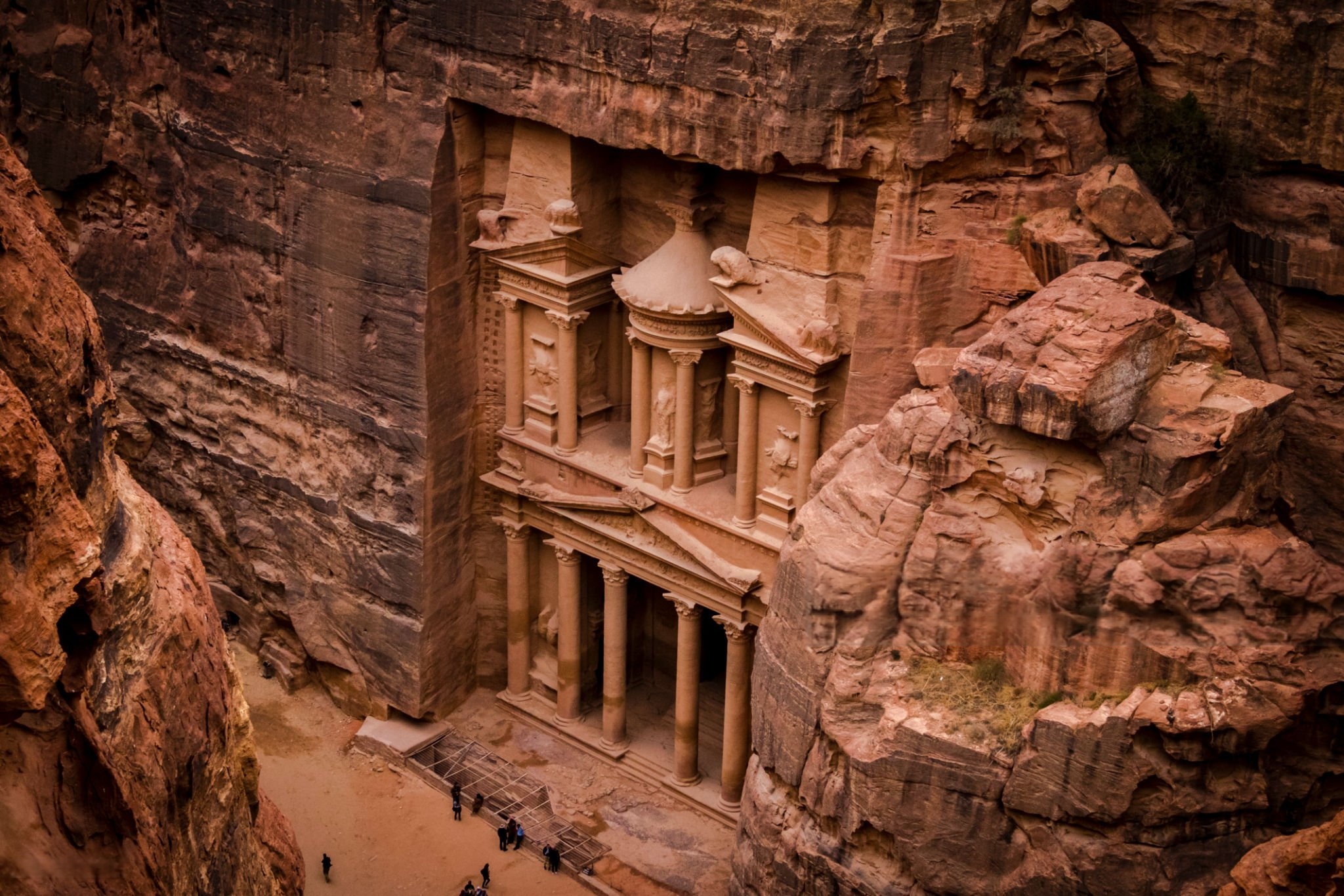



Comments are closed